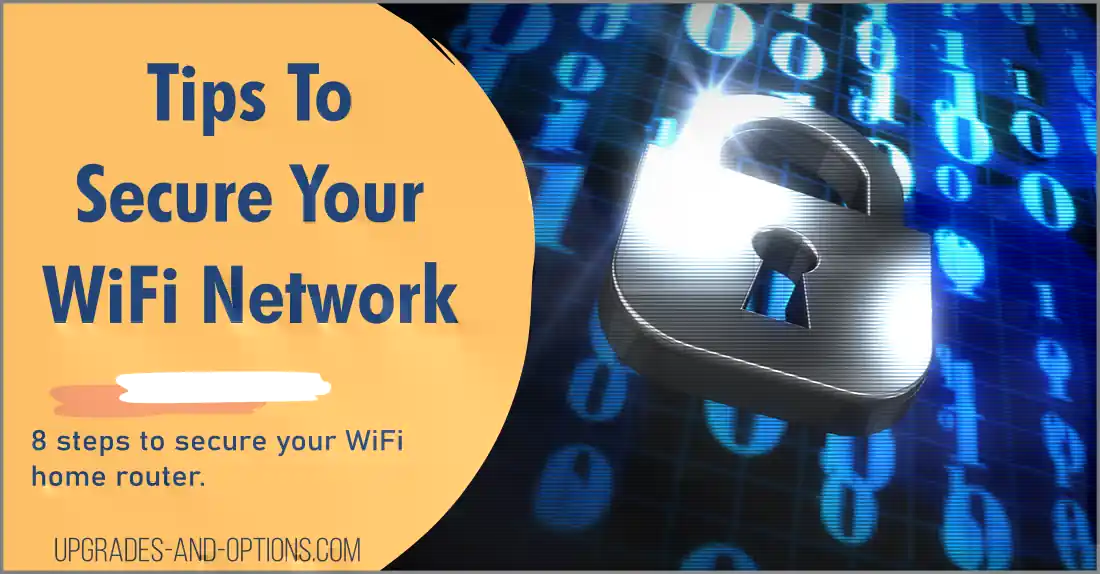See the 8 tips to secure your home WiFi network
- Most people don’t give much thought to the security of their home WiFi network. They are incredibly convenient, but they can also be vulnerable to attack.
- A secure WiFi network is important, and you need to take steps to protect yourself and your data. In this blog post, we will discuss some tips to secure your home WiFi network.
- See even more Tech Information Guide articles.
So if you are wondering about “How to secure my WiFi router at home?”, or “How to protect my WiFi from the neighbors?” this article will be of help.
8 Tips To Secure Your Home Wi-Fi Network
By following these 8 tips and making the necessary changes to your home WiFi router, you can make your home network more secure.
1. Change The WiFi Router Password
Change the factory default password on your router. This is the first and most important step in securing your WiFi network.
The vast majority of people never change the password on their router, which means that anyone who knows the factory default password can access your wireless network.
2. Change The SSID Name
Change the SSID. The SSID is the name of your WiFi network. By changing it, you make it more difficult for someone to guess your password.
You might want to change it for security reasons, or if you move to a new location and need to set up a new network. To change your WiFi SSID, you’ll need to access your wireless router’s settings page. This will usually involve opening a web browser and typing in the router’s IP address.
Once you’re on the settings page, look for the wifi SSID setting and enter the new name you want to use.
Save your changes and then reconnect all of your devices to the new wifi network.
3. Turn Off Network Name Broadcasting
In the previous step, you changed the SSID name. It is also a good idea to not broadcast this name to make it even more difficult for someone to find your network.
On most WiFi routers, this setting is called “SSID Broadcast” or “Network Name Broadcast”. You’ll need to access your router’s settings page to find this setting. Once you’ve found it, turn it off.
Keep in mind that this will make it more difficult for you to connect new devices to your network, so you’ll need to know the SSID name and password.
4. Enable Strong Encryption
Use a strong encryption method. WEP is an old and insecure encryption method. WPA and WPA2 are much more secure.
In order to protect your data and prevent others from accessing your WiFi network, it is important to enable strong encryption on your router.
The most common type of wifi encryption is WPA2, which offers a high level of security. In order to enable WPA2 encryption on your router, you will need to access the router’s configuration page.
This can usually be done by typing the router’s IP address into a web browser. Once you have accessed the configuration page, you will need to enter a password and select the WPA2 option from the menu.
After you have saved your changes, your wifi network will be encrypted and more secure.
5. Set Up A Guest Network
Use a guest network. This can be a great way to give visitors access to the internet without giving them access to your personal network.
Most wifi routers these days come with the ability to create a guest network. This is a great feature to have if you entertain often or want to give your friends and family access to your wifi without sharing your password. Here’s how to set up a guest network on your router:
- Log into your router’s web interface. This will typically be done by entering the router’s IP address into a web browser. Consult your router’s documentation on how to find the address. It is commonly 192.168.0.1.
- Once logged in, look for the guest networking feature. This may be under a section labeled “wireless,” “security,” or something similar.
- Enable the guest network and give it a name (SSID). Be sure to generate a strong password for the network.
- Save your changes and restart your router.
Now, when anyone tries to connect to your wifi, they’ll be given the option of connecting to the main network or the guest network. Guests will be able to access the internet but won’t be able to see any of the other devices on your network.
6. Use MAC Filtering
Enable MAC filtering. This allows you to specify which devices can connect to your WiFi network. This can be a great way to secure your network if you have concerns about people accessing it without your permission.
By creating a filter that only allows devices with specific MAC addresses to connect to your WiFi, you can be sure that only authorized devices are accessing your network. Here’s how to create a MAC filter for your WiFi router:
- First, log in to your router’s web interface. This will usually be accessible by typing the router’s IP address into your web browser.
- Once you’re logged in, navigate to the WiFi settings page. On this page, you should see an option to create a MAC filter.
- Click on this option, and then enter the MAC addresses of the devices that you want to allow to connect to your WiFi. Be sure to click “Save” when you’re finished.
Your WiFi router should now only allow devices with the specified MAC addresses to connect.
7. Create A Firewall
Protect your network with a firewall. A firewall can help to block malicious traffic and protect your network from attacks.
A WiFi firewall is a router security feature that helps to protect your network from unauthorized access. There are two main types of wifi firewalls: hardware and software. Hardware WiFi firewalls are physical devices that plug into your router and provide an extra layer of WiFi protection. Software WiFi firewalls are typically built into router firmware and work to block incoming connections from known malicious IP addresses.
In order to create a WiFi firewall, you will need to log into your router’s web interface and find the section for security settings.
From there, you can enable the firewall and configure it to best suit your needs.
8. Apply Updates
Keep your WiFi router software up to date. Router manufacturers regularly release firmware updates that can improve security and fix vulnerabilities.
Updating your WiFi router’s software is important to ensure that you have the latest security patches and features. Most routers will have a web interface that you can access by typing in the router’s IP address into a web browser.
From there, you should be able to find the firmware update page (it may be under a tab labeled “administration” or “settings”).
Next, you can usually either upload the firmware file manually, or there may be an option to have the router check for updates and install them automatically.
For a TP-Link device, the firmware steps can be found here.
For D-Link routers: see the steps to check the firmware.
Once the update is installed, restart your router and you should be all set.
How Secure Is WiFi?
WiFi routers use various security features to protect your data. When these features are properly configured, your WiFi network will be quite secure.
However, no security measure is perfect, and there are almost always ways for someone to break into a system by using software flaws or security holes. Be aware of the potential risks and take steps to secure your network accordingly.
The best way to protect your data is to use a combination of security measures. By using the 8 tips in this article, you can make your WiFi network much more secure.

In addition, when connecting to public WiFi, a whole new set of challenges arise. Be sure to take precautions when using public WiFi, such as these 5 tips:
- Connect only to known SSID names. Bad actors or hackers can create a “false” network and try to get you to connect to it so they can steal your data.
- Avoid using public WiFi for sensitive activities (e.g. online banking, email, etc.).
- Use a VPN when possible. This helps shield your data from prying eyes on the network.
- Connect to secure websites only (look for the “HTTPS” in the URL).
- Avoid sharing personal information.
Tips To Secure Your Home WiFi Network – Summary
Protect your information while connected to your home WiFi network by following the tips outlined in this article. They are steps most anyone can do as long as they have access to their home wireless router.

J.S. is the owner, content creator, and editor at Upgrades-and-Options.com. I’ve worked in the IT and Computer Support field for over 20 years. The server hardware in my computer labs has mostly been IBM, but I’ve supported Dell, HP, and various other hardware. In addition, as part of my lab administrator responsibilities, I’ve learned, supported, and repaired/upgraded network hardware such as Cisco routers and switches. READ FULL BIO >>
Related Posts:
-
IdeaPad Gaming 3 Upgrade (Full Specs)

Updated: 11/01/2022 Upgrade the RAM and SSD drive in your Lenovo IdeaPad Gaming 3 laptop plus check out the specifications of the laptop. Yes, upgrading the IdeaPad Gaming 3 laptop including part numbers and instructions is in this article, plus specs. How To Upgrade RAM And SSD On Lenovo IdeaPad Gaming 3 Laptop And if…
-
Level Up: 10 Hacks to Boost Laptop Speed

As a tech professional with over 20 years of experience, I truly understand the importance of a laptop’s performance in today’s fast-paced technological world. With most of our professional, academic, and personal tasks entwined with computers, a slow laptop can be an obstacle to productivity and an effective routine. In this article, I will address…
-
How to Easily Update Realtek 802.11 N WLAN Adapter Drivers for Seamless Connectivity

Keeping your Realtek 802.11 N WLAN adapter drivers up-to-date is crucial for maintaining optimal wireless connectivity and performance. This guide provides detailed steps for updating these drivers, with specific tips for Lenovo laptop users. Why Update Your Drivers? Updating your Realtek Wireless LAN driver can resolve several issues, such as: Two Methods for Updating Drivers…


